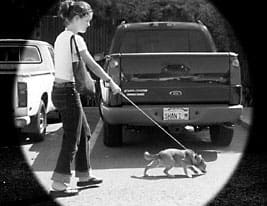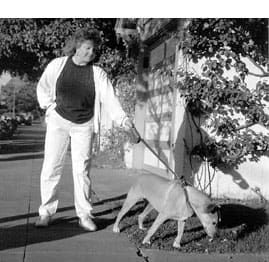My husband and I acquired two (temporary) canine foundlings last week. Julie is a five-month-old purebred Akita puppy that we rescued from our local shelter, where her cage card identified her as a Shepherd/Husky mix. Her prospects for adoption were dismal, given that the shelter euthanizes 85-90 percent of incoming animals.
Our second castaway, Princess, is a three-year-old Beagle mix. My husband and I were driving down a busy highway when we spotted her, hunched in the middle of the road, defecating while cars swerved around her on both sides. Princess was wearing a collar and tag, but her owners had moved, and she ended up staying at our house for several days while we tracked down their new phone number and location.
While Princess was with us, I took her out on several occasions to cruise the neighborhood where she was found, to look for her home and to tack up “Found Dog” signs. Each time we went for a walk, I was amazed by the determination with which this little 30-pound dog could pull on a leash. I work with dogs who pull all the time in my dog training business, and believe me, Princess is an Olympic-class puller.

In contrast, Julie (the shelter rescue) heels beautifully. From the moment I took her out of the shelter on a leash, she has shown no desire to pull. Her natural inclination is to stay close to me when we walk, and it was a simple matter, in one short week, to teach her to heel nicely by my side and sit every time I halt, whether she’s on or off leash.
The stark contrast between the walking styles of these two wayward woofers prompted me to ponder the whys and wherefores of leash-pulling behavior.
The gene pull
Dogs pull on their leashes for lots of reasons. Some leash-pulling is attributable, at least in part, to genetics. Scent Hounds – the category into which Beagles fall, and from which at least some of Princess’ ancestors claim heritage – tend toward pulling. They are bred to put their noses to the ground and go, ignoring the discomfort of brambles, briars, icy creeks, or the minor bother of a leash. (Indeed, I once had a Bloodhound, Otis, who was an invaluable hiking companion in California’s rugged coastal hills. When I felt my strength waning, I could put a hand on his collar and let him pull me up the steep paths.) The Arctic breeds – Huskies, Malamutes, Samoyeds and the like – were bred to haul sleds, and are also natural candidates for pulling. Akitas, on the other hand, were Japanese hunting and guarding dogs. They tend to be dignified and docile, albeit protective. Hence, Julie’s genes make her less likely to pull.
Genes aren’t the whole story, however. Genetics are responsible only for our dogs’ predisposition toward certain behaviors. The way we interact with them can influence them toward, or away from, their preprogrammed tendencies – at least to some degree. I know a couple Malamutes and Samoyeds who heel beautifully, and I’ve seen Akitas flying their owners behind them like kites.
Like most behaviors, it’s easiest to teach our dogs good leash manners if we start with blank slates – young puppies who have not yet learned to pull. All of the basic training principles we use in positive dog training apply to the leash challenge. Here’s a quick review of some of the key ones:
• All living things repeat behaviors that are rewarding to them. Behaviors that are consistently rewarded increase in frequency.
• Behaviors that are not rewarded will diminish and eventually extinguish.
• It’s easier and more effective to manage or prevent behaviors we don’t want than it is to correct them after they have become established. (This is why it’s easier to start with puppies, before they have already learned undesirable behaviors like pulling.)
• Rewards (or reward markers, such as the Click! of the clicker) must ideally occur when the behavior happens (or within one to two seconds) in order for the dog to associate the reward with the desired behavior. (See “Clicks for Tricks,” WDJ May 2000.)
• We can train more effectively if we think in terms of what we want our dog to do rather than what we want him not to do. Instead of thinking that we want our dog not to pull on the leash, think about wanting him to walk nicely by our side. Focus on the positive.
Taffy pull
Most dogs who pull do so, whatever their genetics, because we humans are relatively slow and boring. Dogs want to explore their environment, and they want to do it a lot faster than we can move. Think about it. If you take your dog for a hike off-leash, does he trudge along next to you, or does he range ahead, run circles around you, dash up hills and down vales, leaving you to eat his dust? Chances are good that unless he’s in his twilight years or physically impaired he’s still doing donuts around you even when you’re dragging your tired body back to the car at the tail end of the hike.
He also finds the environment to be infinitely rewarding. All the while he’s charging about, he’s being rewarded with great smells to sniff, deer poop to roll in and eat, squirrels to chase, ball and sticks to fetch, other dogs to romp with, ponds to swim in and puddles to splash in. We can only imagine all the spectacular sensory stimuli that thrill our dog during a good romp. It’s no wonder that a sedate walk on leash around the block is dull for him!
Dogs pull because we let them pull. More accurately, we teach them to pull. When John Q. Dog Owner brings eight-week-old Taffy home, he puts on the collar and six-foot leash and takes her out for her very-first-ever walk. A neighbor stops to admire the pup, and stands chatting with John for a few minutes. Taffy gets bored, and spots a beetle 10 feet away that catches her interest. She wanders to the end of the leash and leans into her collar. John eventually notices the pressure, and, still talking to his neighbor, moves in the direction of the Taffy pull. Taffy gets to play with her beetle, and files away a critically important bit of information in her puppy brain: “Pulling gets you where you want to go.” She’ll test this hypothesis several times, and each time it works – when she pulls on the leash to investigate something, John follows. Taffy is soon convinced that pulling on leash is very rewarding – it gets you what you want!
To make things worse, John subconsciously develops a comfort level with a tight lead. Tension on the leash lets him know where Taffy is. So even on those occasions when she is not pulling, John lifts his arm or pulls it back to keep tension in the leash. Taffy eventually accepts that a tight leash is the norm. Not a good foundation for polite leash-walking!
Pulling your own weight
Whenever you and your dog are together, one of you is training the other. The ideal arrangement is that you are the trainer and Taffy is the trainee, at least the majority of the time. From Day One, you need to make sure that Taffy gets rewarded for desirable behaviors, and that you prevent her from being rewarded by undesirable ones.
In terms of leash-walking, this means that you need to make yourself infinitely more rewarding than the environment, at least at first, in order to program “loose-leash walking is the norm” into Taffy’s puppy brain. You need to make a conscious effort to reward her for staying near you (loose leash) and not let her be rewarded when she goes too far away (tight leash). At the same time you have to avoid falling into the common trap of taking up the slack in order to keep tabs on Taffy. That’s what eyeballs are for. Let’s take another look at our friend John Q. to see how he can accomplish this:
John brings Taffy home, puts on her collar and six-foot leash, and takes her out for her very-first-ever walk. In his pocket he has a large supply of tasty treats and a clicker. He heads out the back door to practice in the back yard where he won’t be distracted by neighbors. As soon as he and Taffy reach the patio, he stops and clicks the clicker in his pocket. The sharp sound catches Taffy’s ear and she looks up at him, curious. He feeds her an irresistible treat. “Great game!” Taffy thinks, and keeps her eyes glued to John. He clicks and treats again, several times in a row.
Given this sort of interaction, Taffy has no interest in the surrounding environment – she’s enchanted by this living, breathing treat machine and the funny noise that signals to her that another treat is about to magically appear. She sits so she can watch the man’s face more easily, and the Click! happens again. Cool! She stands up to eat the treat, then sits again to watch John. Click!
A light bulb goes off in Taffy’s head. “Hey!” she thinks. “Every time I put my bottom on the ground, the Click! happens and a treat appears. This ‘bottom-on-the ground’ thing is a great gig!”
Now John starts to walk forward, making sure to keep his hand down by his side and a valley in the leash. Taffy, eager to keep the treat machine in sight, hustles to keep up with him. John clicks the clicker and feeds her a treat. He takes another step, and Taffy is right there with him. Click! and treat.
“Hey!” thinks Taffy. “There’s more than one way to get a treat! I’m stickin’ close to this guy!”
Pushing the envelope, slowly
Just then a leaf falls from a nearby tree, catching Taffy’s attention. The pup’s ears perk up, and she bounces toward the leaf. The leash tightens, and stops her forward progress. Taffy strains toward the leaf – she really wants it! John doesn’t budge. Finally, frustrated, Taffy backs up a step and sits. Click! John lets her know that a loose leash earns a reward. Taffy spins on her tail at the beloved sound and bounces back to John for the tidbit.
As soon as she eats the treat he moves forward quickly so she can reach the leaf without tightening the leash. She sniffs it briefly, decides it isn’t all that wonderful after all, and looks back up at John. He clicks and treats her for turning her attention back to him, then walks forward again, clicking and treating – every one to three steps – to teach Taffy that staying near him with the leash loose is a very rewarding behavior.
If she starts to move out in front of him, he sometimes turns around and goes the other direction. Now she’s behind him again, and he has lots more opportunities to Click! her for keeping the leash loose. He also talks to her in a happy voice, not a commanding one, so that staying near him is fun for her. If Taffy does reach the end of the leash and starts to pull, he stops again, waits for her to put slack in the lead, clicks, treats, and starts forward once more.
After five minutes of this, John stops, unhooks Taffy’s leash, and spends another 10 minutes playing “chase the squeaky” with her. Every once in a while he walks a few steps, and if she walks next to him, he clicks the clicker and feeds her a treat. Taffy starts to realize that it’s rewarding to be near John when she is free as well as when she is on leash. When she takes a time-out from play to pee in the corner, John clicks and rewards her for that as well.
“Wow,” Taffy thinks. “There are lots of things I can do to make that wonderful Click! happen and treats appear – this is very cool!”
Later that day, John decides to try Taffy on the front sidewalk, since she did so well in the back yard. As he works with her, the neighbor comes out to chat. John stops to talk, but keeps an eye on Taffy at the same time. As long as Taffy is sitting or standing quietly near him, he gives an occasional Click! and treat. He hands the neighbor a couple of treats, and tells her that when Taffy sits she can feed Taffy a goodie and pet her. Taffy has no desire to leave. After a short conversation, John politely excuses himself from the neighbor so he can return his full attention to Taffy’s training session.
John has already laid the beginnings for a very solid foundation for Taffy to grow into a well-mannered and well-educated canine companion. If he keeps it up, she will never learn to pull on her leash.
Pulling your leg
The same method that John Q. used for Taffy also works on adult dogs, but you can expect to take more time and make more of an effort to convince the adult dog that pulling isn’t going to pay off any more. The longer a dog like our foundling Beagle, Princess, has been reinforced for pulling, the greater the challenge to persuade her to stop. It can sometimes seem like pulling hen’s teeth – difficult to do and not very productive.
It can be done, however, especially with the help of the right preparation. You may need to find an arsenal of irresistible treats to compete with the known rewards of Princess’ environment. Freeze-dried liver, chicken, steak and roast beef generally rank high for most dogs. You will also need to start working with her in a very low-distraction environment, and graduate to the front sidewalk only after Princess seems to be getting the hang of it. You may also need the help of one of the many helpful no-pull products on the market.
There is a long list of products that – according to their makers – will single-handedly teach your dog not to pull. If you believe these manufacturers, I know of a lovely bridge for sale . . . In truth, no-pull products can help you control your dog while you reprogram her to adopt a more civilized walking style. Head halters (see “Head Halters, Right And Wrong,” WDJ June 2000 and “What A Drag,” WDJ July 1998), stretchy leashes, beepers, and no-pull harnesses can all offer a greater degree of immediate control. Unfortunately, they can also become a crutch – so that your dog will walk nicely while wearing the special equipment, but pull with just as much determination as ever when you take off the halter or harness.
This doesn’t mean that your no-pull equipment of choice is worthless. It can help you teach Princess to walk politely on leash – as long as you combine it with a positive reinforcement training program to teach her to walk nicely, with or without the crutch. Princess needs to decide that it is more rewarding to walk with you than to pull. Combine your favorite gentle control tool with clicks and treats, be consistent about never rewarding her for pulling by allowing her to get where she wants to go, and your Pulling Princess will, in time, be content to prance by your side instead of trying to drag you down the drive.
Our Princess didn’t learn to stop pulling during the short three days she was with us. She returned home to her family, people who love her just the way she is and don’t care if she pulls. She will be an Olympic-class puller for the rest of her life. Julie, the rescued Akita puppy, will be with us for a few more weeks, recovering from kennel cough and getting spayed before we place her in a new, carefully screened home with an owner who will continue to reinforce her good leash behavior. If you’d rather have a Gentle Julie than a Pulling Princess, get out your clicker and treats, and start your leash training program – the sooner the better.
-By Pat Miller
Pat Miller, WDJ’s Training Editor, is also a freelance author and professional dog trainer in Chattanooga, Tennessee.






